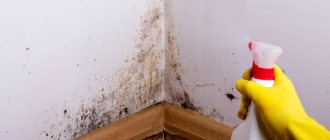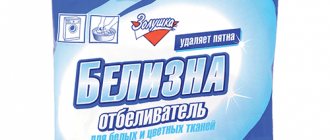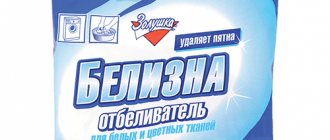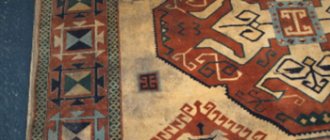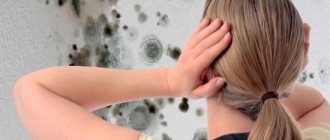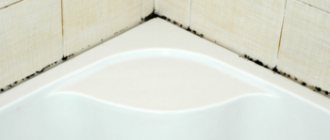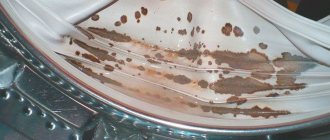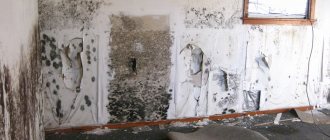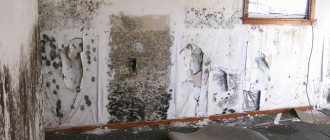Mold is a dangerous phenomenon that requires immediate elimination. It can appear on any surface, and they fight it with the help of fungicidal and folk remedies. Whiteness also helps a lot against mold on the walls. The known composition copes not only with fungus, but also with other pathogenic microorganisms. The product is easy to dilute and apply.
Important! A significant advantage of the composition is the positive effect. There is also a small drawback - moldy surfaces will have to be treated several times. However, given the competitive price, Whitewash against mold on walls remains a popular method in the fight for cleanliness and safety.
Is Whitewash effective against mold?
Sodium hypochlorite is an affordable product that has been used for a long time to maintain cleanliness in any premises. Treating mold with White allows you to additionally remove pathogenic microflora and fight pathogens. However, it is customary to use the prepared disinfectant solution:
- For treating small mold colonies. She may not be able to cope with a big defeat.
- In any climate zone. The composition is used in dry and climates with high moisture levels.
- For repeated cleaning. Often, one time is not enough to clean the surface.
Sodium hypochlorite is a disinfectant and bleaching agent, and therefore it is not recommended to use it frequently to remove fungus. It is better to choose a special product that is safe for humans.
Practical actions
If you find fungus or mold in your apartment, then don’t hesitate - start fighting it as quickly as possible. Moreover, during repairs, it is better to do this even before wallpapering. Practical actions are as follows:
- First you need to remove the wallpaper from the wall.
- After this, it is necessary to remove the damaged layer of plaster using a spatula or a stiff brush.
- Your next action should be to treat the wall with a cleaning compound. This will help open the pores and remove the cement film.
- Next, you can proceed to preparing a solution based on a store-bought mold removal composition. It is best to use an antiseptic with an antifungal effect. They need to use a roller to process all surfaces, without missing a single area. With the help of an antiseptic primer, you can easily return the wall to its usual appearance, and in addition to this, increase its strength characteristics and clean it of dirt particles. In addition, the composition will make the finish more durable.
- Then you need to prepare a dry waterproofing mixture. And also, instead of it, you can buy ready-made in the store. When the composition is ready for use, it is applied to the wall using a brush.
- Next, you need to treat the surface of the wall with a deep penetration primer.
- After this comes the turn of plastering and putty.
- Then the surfaces must be treated again with a deep penetration primer.
- At the end, all that remains is to stick new wallpaper on the walls.
Remember that treating the walls before wallpapering is mandatory, otherwise all your efforts will be in vain.
But at the same time, along with them, you can use a lot of improvised means for treating mold, which can also provide good assistance in the fight against microorganisms. However, the best way to prevent mold from appearing in your apartment is to regularly carry out preventive measures. It is necessary to ensure that the humidity of the room remains at a relatively low level, and for this all rooms must be regularly ventilated.
Save
When to use mildew whitening?
You can remove mold with White when the affected area is small. If the fungus has managed to grow over several square meters, you will have to remove it using special compounds. They are safe for humans and quickly deal with fungal spores, preventing their reappearance.
To treat a large affected area, it is recommended to call specialists. The craftsmen go to the site with a set of tools and special equipment, and use chemical protection. But the main thing is to eliminate the cause of the fungus. It is not advisable to treat walls, floors and ceilings in a room with constant high air humidity. After a short time, the mold will appear again.
White is quite effective against mold on walls . But with the constant appearance of pathogenic flora, it is not advisable to use the composition. It is necessary to eliminate the cause of the fungus.
Mold has appeared on the wallpaper - should we clean it or re-glue it? There is a solution!
As soon as mold appears on various surfaces of the apartment, it should be removed immediately. Otherwise, it will not only spoil the appearance of the walls, but will also have a very negative impact on the health of all household members. To remove mold from wallpaper, it is not necessary to re-glue it. Under certain conditions, you can do without cosmetic repairs by simply using industrial fungicides or home remedies. But simply disinfecting the room will not be enough. In order to completely destroy mold, it is necessary to create unfavorable conditions in the apartment for its proliferation - reduce humidity, increase temperature and allow sunlight to freely penetrate the rooms. It is this set of measures that will allow us to completely forget about this problem.
What surfaces can be treated?
Whiteness from mold in the bathroom , toilet or kitchen; in other rooms it can be used to treat walls, ceilings, window and door openings, and floors. Furniture should be cleaned carefully, without touching soft fabrics with the composition. Bleach can be used to eliminate pathogenic flora on:
- Varnished wood. The product can also be applied over the protective film. Untreated wood should not be wetted with the composition.
- Concrete and composite materials.
- Brick and ceramics.
- Metal and plastic.
- Leather and leatherette, other types of fabrics.
Important! to remove mold with bleach from fabric materials. Colored cotton surfaces should not be wetted with bleach.
The liquid can also be used to remove fungus from wallpaper and walls under various building coverings. It is also ideal for treating baseboards, for which you can use a spray bottle.
Types of fungi
There are four types of fungi, each of them is different and harmful in its own way. To understand how to treat the walls in an apartment against fungus and mold, you first need to figure out what type of harmful organisms you have.
The options could be like this.
Common mold
Such colonies grow on stones, concrete and wallpaper. Initially appears as small dots of gray, black, blue or brown. Soon the dots turn into huge spots. Sometimes mold can be seen as glowing colonies of harmful microorganisms.
Important! If you start the problem, the fungus will corrode the building materials almost throughout their entire depth.
blue fungus
blue fungus
It grows on wood surfaces in the form of a gray or blue coating. The danger of blue is that it significantly increases the moisture content of the tree, which soon leads to its destruction. Also, high humidity becomes a favorable environment for the formation of entire colonies of blue fungus.
Important! Most often it affects pine
Rotting fungus
This type of colony is white and brown in color and also appears only on wood. When it appears, the walls become gray, the material decomposes from the inside and loses its strength. There are several types of this rot:
- White rot - when it appears, the color of the tree practically does not change.
- When brown rot forms, stripes of yellow, brown and black colors appear.
As a result of such phenomena, the tree begins to bulge and split.
Important! White house fungus is the worst enemy of any wooden floor. In a month it can completely ruin a wooden parquet with boards 40 mm thick
Previously, in case of infection with this mold, houses were simply burned so as not to infect neighboring ones.
Efflorescence
Efflorescence can also be called very harmful. They spread on bricks and concrete. This fungus appears as a white salt coating. Over time, it also penetrates deep into materials and destroys them.
Now take a closer look at the mold that has formed on your wall. Considering the above facts, determine what kind of fungus has broken into your house. It is its type that determines what kind of treatment of the walls in the apartment against fungus and mold will be done.
Which Whiteness to choose?
Standard products should be selected for cleaning. It is not marked “for linen”. You can find products in hardware stores. It is offered in supermarkets in the cleaning products section.
Attention! It is enough to buy only 1 liter of liquid so that it is enough for repeated surface treatment. You can use one bottle to clean several square meters.
“Grandma’s” method of deliverance
Nowadays, many special means have been invented to destroy mold. One of the most effective and affordable is whiteness. The only caution when working with this caustic folk remedy is that you are not allergic to chlorine-containing components.
In order for mold to go away forever, you need to understand the reason for its appearance. Regular cleaning and airing will not lead to the desired result. This method is temporary and does not eradicate the source of active reproduction of a specific microorganism.
Having figured out the cause of the appearance of a fungal colony, you can take the necessary preventive measures, and then begin to eliminate traces of mold and the consequences of its vital activity.
How to dilute bleach to clean mold?
White mold cleanses well - reviews allow you to evaluate the effectiveness of this application. For the composition to be useful, it is necessary to dilute the product with water in the following proportions:
- 1:1. Concentrated liquid is suitable for cleaning mold from metal, brick, concrete.
- 1:2. Concentration suitable for processing and disinfection of ceramics and plastic.
- 1:4. The product will allow you to process delicate materials - wood, fabric, leather.
The liquid can only be applied in its pure form in non-residential and infrequently used areas. This method can be used to treat attics, basements, utility rooms, and warehouses with non-food products. The product should not be used in its pure form in residential premises.
Cleaning wallpaper, depending on its type
In order to properly clean walls from mold, you need to know what methods can be used for a certain type of wallpaper.
Paper wallpaper is not so easy to clean. They should not be wetted with water or any industrial anti-mold products should be used. Therefore, the so-called dry method should be applied to such a surface. It consists of thoroughly drying the paper wallpaper using a hair dryer or a hot iron. After this treatment, the remaining mold is removed with a soft brush. If the wallpaper has come off a little due to moisture, you should dry and sweep the wall, and then re-glue the wallpaper. After the glue has dried, the treated area should be ironed again with a hot iron.
This method is not very effective. Therefore, if you cannot get rid of the mold, you will have to buy new wallpaper and make cosmetic repairs.
If non-woven, acrylic or washable wallpaper is affected by mold, you can clean it using both industrial and home remedies. They tolerate moisture and friction well, but do not like high temperature treatment too much.
Terms of use
Whiteness will help against mold if you follow the recommendations on proportions. You should work with such a product with great care.
Important! All chlorine-containing substances are hazardous to health! Processing should be carried out only in the absence of household members and workers. After application, you should ventilate the room and do not use it for work or life for some time.
To allow Whiteness to get rid of mold on the walls , you should adhere to the following procedure:
- Examine the affected areas.
- Remove everything that is in it from the room. If this is not possible, it is recommended to clean at least the treatment area.
- Fabric products should be removed from the premises. Otherwise, they will absorb unpleasant odors.
- Open windows and doors before starting work.
- Turn off hoods, if installed.
- Wear protective equipment. If the composition gets on an open area of skin, rinse it well with water.
- The floor should be covered with a protective film, especially when the ceiling and walls will be treated.
- Cover the finishing materials with film (if they are not covered with mold).
- Dilute the composition in water.
- Apply a thin layer of white to the surface. Use sponges, brushes, rollers.
- It is not only the affected area that needs to be treated. You should cover another 20–30 cm of the surface around.
- Wait 10 minutes.
- Clean the area - use a brush.
- Remove excess moisture. To do this, use paper, dry wipes or towels.
- Wait for the area to dry completely.
The surface can dry up to two days. You should not cover it or put things on it at this time. Sometimes re-processing is required. It is recommended to carry it out every 5–7 days.
How to deal with mold stains on clothes?
It is not always worth throwing away something that has dangerous stains on it. Some types of fabric can be treated with chlorine-containing liquids. However, not all materials tolerate such substances well. Colored and thin materials are not resistant to bleach. Embroidery, appliqués, drawings, and decor should not be subjected to such processing.
White cotton ones can be treated with the composition. To do this, it should be diluted in a proportion of 1 tbsp. l. 3 liters of water, and then moisten the stain or soak the entire thing. The duration of such treatment is 5–15 minutes. It all depends on the fabric and type of stain.
Wallpaper processing
Often black mold is hidden under the surface of the wallpaper - Whiteness allows you to cope with an experienced phenomenon. This is especially true for rooms with high humidity and poor ventilation. Often the furniture is placed close to the wall. There may not be any gaps for ventilation. That is why the upholstery often suffers from black or green spots.
A small area can be treated, leaving the wallpaper in place. It is important to apply Whiteness not only to areas marked by fungus. Additionally, another 20–30 cm of surface should be covered.
If the affected area is large, you will have to remove the wallpaper. The surface is covered with a thin layer of the composition and then dried. You should wait a few more days and repeat the treatment.
Prevention
In order to forget in the future what a fungal nail looks like in general, you need to adhere not only to the standard rules for the prevention of this disease, but also directly engage in periodic courses of treatment at home. Putting all this together, the instructions for use should look like this:
- Once or twice a week you need to make soda baths with the addition of laundry soap, which will help neutralize the infection if it occurs;
- It is worth considering buying new shoes if the ones you are using fit tightly on your feet and cause them to sweat. Also, do not forget about the need to treat shoes with antiseptics;
- Socks made from synthetic materials should be avoided;
- After bathing, do not ignore wiping your feet until they are completely dry. Moreover, for this you must have a separate towel;
- Women should only get pedicures from well-known specialists, since there are frequent cases of fungal infection in beauty salons where instruments are not sanitized;
- To prevent the skin on your feet from cracking and calluses from rubbing, you can use special foot creams;
- We also don’t forget about immunity, since a strong body is always ready to cope with diseases on its own.
Precautionary measures
It is important not only to learn how to treat mold with Whiteness . The risk to the master and surrounding people should be eliminated. For the process to be effective but safe, it is important:
- Use chemical protective equipment - mask and gloves. It is recommended to wear thick pants and glasses.
- Before applying the composition, open the windows in the room.
- Try not to allow the product to come into contact with unprotected areas of the skin.
- Use a brush to apply the composition.
If a large surface is affected by fungus, the removal of mold with Belize should be trusted to experienced professionals. The called team quickly treats surfaces using disinfectants and protection. Often one such treatment is enough to prevent the fungus from reappearing.
| Room area | Impregnation | Mechanical stripping | Disinfection from spores | Microwave drying of walls | Complex (3 year warranty) |
| 1-2 sq.m. | from 1000 rub. | from 1000 rub. | from 500 rub. | from 2000 rub. | from 3500 rub. |
| 3-5 sq.m. | from 800 rub. | from 850 rub. | from 350 rub. | from 2000 rub. | from 3000 rub. |
| 5-10 sq.m. | from 650 rub. | from 700 rub. | from 200 rub. | from 1800 rub. | from 2800 rub. |
| 10-20 sq.m. | from 500 rub. | from 600 rub. | from 100 rub. | from 1500 rub. | from 2500 rub. |
| 20-50 sq.m. | from 400 rub. | from 500 rub. | For a present* | from 1500 rub. | from 2500 rub. |
| 50-100 sq.m. | from 300 rub. | from 500 rub. | For a present | from 1500 rub. | from 2000 rub. |
| More than 100 sq.m. | negotiable | ||||
| LINEAR METER (along the baseboard, along the seams, along the joints of the walls) | 1000 rub. |
Assessing the scale of infection
When the apartment is too humid, cool and poorly ventilated, there is a high probability of surfaces becoming infected with mold. If this has already happened, first of all it is necessary to conduct a thorough inspection of all rooms. Most often, the fungus affects walls in bathrooms, but it can also occur in other places. Very often, mold spores settle on wallpaper, in closets or under baseboards (this situation can arise in a corner apartment where the walls of the rooms face the street). The kitchen usually suffers least of all, since there are not very favorable conditions for the spread of mold (it does not like high temperatures, more than 22°C).
If black spots appear on the wallpaper, they need to be examined carefully. Assess the area of infection, pull them a little in the area of the joints. If there are no black spots on the wall, and the plaster has not lost its density, then the mold has not had time to spread beyond the wallpaper. In this case, you can try to get rid of it without resorting to repair work. But if, upon inspection of the wall, it is discovered that the plaster has become damp and loose, then extreme measures will have to be taken. All wallpaper should be removed, the walls should be cleaned of fungus and thoroughly dried. At the final stage, before starting to decorate the surface, the walls should be treated with preparations designed to destroy mold and prevent its further occurrence.
